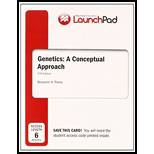
(a)
To determine:
Expected weights in the F1 progeny if genotype AABB is crossed with aabb.
Introduction:
In the given scenario, it is supposed that plant weight is determined by a pair of alleles at each of two independently assorting loci (A and a, B and b) that are additive in their effects. The alleles represented by uppercase letters contribute 4 grams to plant weight, while the alleles represented by lowercase letters contribute 1 gram to plant weight.
(a)
Explanation of Solution
The cross between AABB and aabb is as follows:
F1 (filial 1) generation is AaBb. Its weight can be determined as weight contributed by A + weight contributed by a + weight contributed by B + weight contributed by b (4 + 1 + 4 + 1). So, the plant weight in F1 generation would be 10 grams.
(b)
To determine:
Expected weights in the F2 progeny if genotype AABB is crossed with aabb.
Introduction:
In the given scenario, it is supposed that plant weight is determined by a pair of alleles at each of two independently assorting loci (A and a, B and b) that are additive in their effects. The alleles represented by uppercase letters contribute 4 grams to plant weight, while the alleles represented by lowercase letters contribute 1 gram to plant weight.
(b)
Explanation of Solution
Gametes formed from F1 generation would be AB, Ab, aB, and ab as follows:
F2 generation is produced when F1 generation is inter-crossed and their expected plant weights would be as follows:
Highest plant weight in F2 generation would be of AABB (16 grams) and lowest would be of aabb (4 grams).
Want to see more full solutions like this?
Chapter 24 Solutions
LaunchPad for Pierce's Genetics: A Conceptual Approach (6 month access)
 Human Anatomy & Physiology (11th Edition)BiologyISBN:9780134580999Author:Elaine N. Marieb, Katja N. HoehnPublisher:PEARSON
Human Anatomy & Physiology (11th Edition)BiologyISBN:9780134580999Author:Elaine N. Marieb, Katja N. HoehnPublisher:PEARSON Biology 2eBiologyISBN:9781947172517Author:Matthew Douglas, Jung Choi, Mary Ann ClarkPublisher:OpenStax
Biology 2eBiologyISBN:9781947172517Author:Matthew Douglas, Jung Choi, Mary Ann ClarkPublisher:OpenStax Anatomy & PhysiologyBiologyISBN:9781259398629Author:McKinley, Michael P., O'loughlin, Valerie Dean, Bidle, Theresa StouterPublisher:Mcgraw Hill Education,
Anatomy & PhysiologyBiologyISBN:9781259398629Author:McKinley, Michael P., O'loughlin, Valerie Dean, Bidle, Theresa StouterPublisher:Mcgraw Hill Education, Molecular Biology of the Cell (Sixth Edition)BiologyISBN:9780815344322Author:Bruce Alberts, Alexander D. Johnson, Julian Lewis, David Morgan, Martin Raff, Keith Roberts, Peter WalterPublisher:W. W. Norton & Company
Molecular Biology of the Cell (Sixth Edition)BiologyISBN:9780815344322Author:Bruce Alberts, Alexander D. Johnson, Julian Lewis, David Morgan, Martin Raff, Keith Roberts, Peter WalterPublisher:W. W. Norton & Company Laboratory Manual For Human Anatomy & PhysiologyBiologyISBN:9781260159363Author:Martin, Terry R., Prentice-craver, CynthiaPublisher:McGraw-Hill Publishing Co.
Laboratory Manual For Human Anatomy & PhysiologyBiologyISBN:9781260159363Author:Martin, Terry R., Prentice-craver, CynthiaPublisher:McGraw-Hill Publishing Co. Inquiry Into Life (16th Edition)BiologyISBN:9781260231700Author:Sylvia S. Mader, Michael WindelspechtPublisher:McGraw Hill Education
Inquiry Into Life (16th Edition)BiologyISBN:9781260231700Author:Sylvia S. Mader, Michael WindelspechtPublisher:McGraw Hill Education





